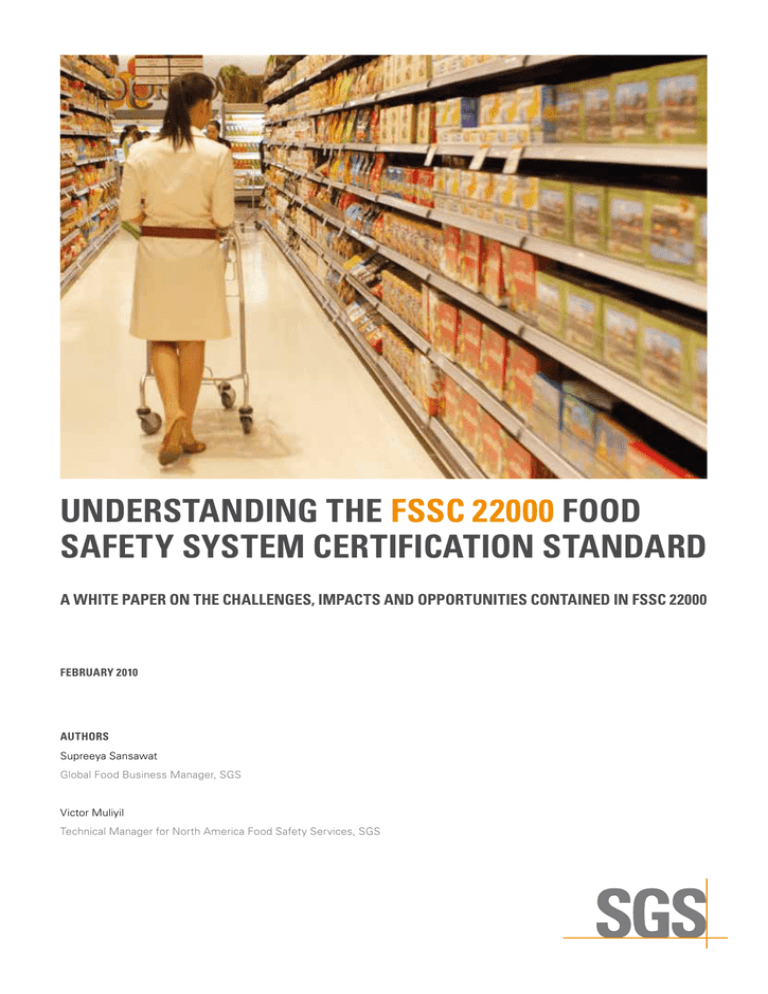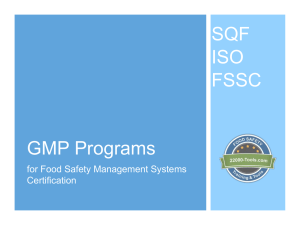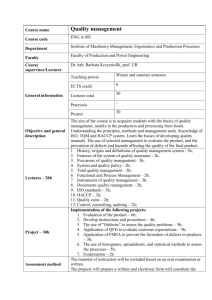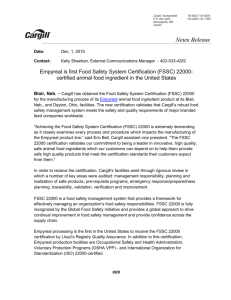
UNDERSTANDING THE FSSC 22000 FOOD
SAFETY SYSTEM CERTIFICATION STANDARD
A WHITE PAPER ON THE CHALLENGES, IMPACTS AND OPPORTUNITIES CONTAINED IN FSSC 22000
FEBRUARY 2010
AUTHORS
Supreeya Sansawat
Global Food Business Manager, SGS
Victor Muliyil
Technical Manager for North America Food Safety Services, SGS
ABSTRACT
The purpose of this document is to provide an introduction to the FSSC
22000 Food Safety System Certification standard requirements. This
document is not intended to be a full explanation of the standard or of
its implementation. Rather, it aims to promote understanding of the
standard and its benefits to organisations doing business at a domestic
or international level within the food industry.
CONTENTS
I. EXECUTIVE SUMMARY
1
II. GLOBAL FOOD SAFETY – A CHALLENGING ENVIRONMENT
2
III. THE CORE COMPONENTS OF FSSC 22000
4
IV. A GLOBAL SOLUTION FOR FOOD SAFETY
8
V. CONCLUSIOn
9
I. EXECUTIVE SUMMARY
Food safety is an issue that will always be on consumers’ minds. Over the years, many regional and customised food safety
standards have evolved in order to enhance food safety and address the issues raised by manufacturers, suppliers,
retailers and consumers.
Recently, the Global Food Safety Initiative (GFSI) fully recognised FSSC 22000 as a new food safety standard. FSSC 22000
incorporates many of the principles of other GFSI approved food safety standards. This allows organisations that achieve
FSSC 22000 certification to meet the requirements of several global retailers or major branded food companies under a single,
internationally recognised food safety management system.
FSSC 22000 presents one of the most comprehensive approaches to a food safety management system for those engaged in the
manufacturing of food items. Because of its basis in ISO 22000:2005, the new standard seamlessly integrates into other quality
management systems such as ISO 9001, ISO 14001 and OHSAS 18001, making it an integral part of any food manufacturing
organisation’s ability to improve quality and ensure safety.
Ultimately, FSSC 22000 combines the benefits of a business management tool linking food safety and business processes with the
ability to meet growing global customer requirements for GFSI recognised supplier food safety system certification
1
II. GLOBAL FOOD SAFETY –
A CHALLENGING ENVIRONMENT
Consumers are becoming more and
more concerned about food safety.
From tainted milk to contaminated
peanut butter, food scares and recalls
have been ever-present over the past
several years. Extended global supply
chains and lack of adequate control
mechanisms are some of the key
reasons. As manufacturers and retailers
make efforts to address deficiencies in
their supply chains, and multiple safety
standards and schemes are proposed
and adopted, progress is being made to
ensure global food safety.
The introduction of FSSC 22000 marks
a major step closer towards a single,
internationally accredited and recognised
superior food safety standard. It
combines the ISO 22000:2005 Food
Safety Management standard with
the Publicly Available Specification
(PAS) 220:2008 and other additional
requirements. The standard has been
fully recognised by the Global Food
Safety Initiative (GFSI), an organisation
committed to benchmarking food
safety management schemes with an
aim towards fostering a convergence
between food safety standards. GFSI
is also focused on improving cost
efficiency throughout the food supply
chain through the common acceptance
of GFSI recognised standards by
retailers around the world.
In 2001, the International Organization
for Standardization (ISO) started the
development of an auditable standard for
the food industry, building on the Hazard
Analysis and Critical Control Points
(HACCP) certification’s role in food safety
management systems. The result was
ISO 22000:2005, issued in 2005. Its aim
was to define food safety management
requirements for companies that needed
to comply with a wide variety of global
food safety regulations.
ISO 22000:2005, however, was not
approved by GFSI at the time due to
weak prerequisite programme content.
To bolster this content, a group of
large multinational companies wrote
an addendum to the ISO 22000:2005
standard, known as the Publicly
Available Specification 220 (PAS
220:2008), issued in 2008.
GFSI agreed that the combination of
ISO 22000:2005 and PAS 220:2008
contained adequate content for
approval, but that there must exist an
industry-owned scheme governing the
combination of these two standards,
along with emphasis on regulatory and
customer requirements.
Consequently, the Foundation for Food
Safety Certification developed FSSC
22000, combining ISO 22000:2005,
PAS 220:2008 and some additional
regulatory and customer requirements.
FSSC 22000 was approved by GFSI
in May 2009 as a global benchmark
in food safety management. Since
February 2010, FSSC 22000 became
the sixth standard to join the stable
of GFSI recognised schemes. This
move helps drive cost efficiency and
consistency in supply chains around the
world when sourcing food and deliver
greater confidence to the end users of
third-party certification whilst providing
flexibility and choice.1
The result is an international, auditable
standard that specifies the requirements
for food safety management systems
by incorporating all the elements of
Good Manufacturing Practices (GMP)
and Hazard Analysis Critical Control
Points (HACCP) together with a
comprehensive management system.
FSSC 22000 gives organisations a way
to demonstrate, in an internationally
understood format, that they have a
comprehensive management system
that meets the food safety requirements
of both customers and regulatory
agencies. The standard has been
designed to cover all the processes
along the food chain that deal directly
or indirectly with the end product being
consumed. It brings everybody along
the food chain under a single food
safety management umbrella, making
it easier to train, implement and audit
the management of food safety at every
level of the food chain.
1
Source: GFSI (www.ciesnet.com)
2
THE ORIGINS OF A GLOBAL STANDARD
1938
Good Manufacturing Practices are enforced by
the US Food and Drug Administration (FDA) as
a result of 1938 Food, Drug, and Cosmetic Act.
1960s
Hazard Analysis and Critical Control Point
(HACCP) principles created.
1998
First British Retail Consortium (BRC) standard
introduced (now a GFSI approved standard).
Late 1990s
GlobalGAP launched (originally as EurepGAP).
May 2000
Global Food Safety Initiative (GFSI)
founded. One of GFSI’s main objectives
is to benchmark food safety management
schemes with an aim towards convergence
between food safety standards.
1995
Safe Quality Food (SQF) standard launched
(a GFSI approved standard).
2004
International Food Standard (IFS) launched
(a GFSI approved standard).
2004
Foundation for Food Safety
Certification founded.
2005
ISO 22000:2005 issued, not approved
by GFSI due to lack of sufficient
prerequisite programmes.
2007
Top seven retailers agree to reduce duplication
in the supply chain through the common
acceptance of any of the GFSI benchmarked
schemes (BRC, IFS, SQF or Dutch HACCP).
2008
PAS 220:2008 issued as a way to establish
sufficient prerequisite programmes for
ISO 22000:2005.
2009
FSSC 22000 issued as a combination of
ISO 22000:2005 and PAS 220:2008.
May 2009
Content of FSSC 22000 approved by GFSI.
Feb 2010
FSSC 22000 fully recognised by GFSI.
3
III. THE CORE COMPONENTS OF FSSC 22000
IN-DEPTH ON ISO 22000:2005
Food Safety Management System
To fully understand the certification
requirements of FSSC 22000, it is
important to include an overview of ISO
22000:2005 and PAS 220:2008 , since
they form the basis of the standard.
In the food safety management system
section, the emphasis is on establishing,
documenting, implementing and
maintaining an effective food safety
management system. This includes
procedures and records that are needed
to ensure effective development, and
implementing and updating of the food
safety management system.
ISO 22000:2005 was designed
to cover all the processes along
the food chain that deal directly or
indirectly with the end product being
consumed. Furthermore, it specifies
the requirements for food safety
management system by incorporating
all the elements of Good Manufacturing
Practices (GMP) and Hazard Analysis
Critical Control Points (HACCP) together
with a comprehensive management
system. This standard is made up of
eight core elements, detailed below.
Scope
The scope focuses on control measures
to be implemented to ensure that
processes are in place to meet customer
and regulatory food safety requirements.
The types of organisations in the food
chain to which this standard can be
applied are the ones that are directly or
indirectly involved in one or more steps
of the food chain, regardless of the size
or complexity of the organisation.
Management Responsibility
The section on management
responsibility outlines the commitment of
top management to the implementation
and maintenance of the food safety
management system. Assigning a food
safety system manager and team,
setting clear policies, goals, emergency
contingency plans and responsibilities,
along with establishment of effective
communication mechanisms within
the organisation and with suppliers or
customers are key elements of this
clause. Regularly scheduled management
reviews ensure that top management is
made aware of the status of the system
and that actions are authorised to correct
non-conformities and continually improve
the food safety management system.
Resource Management
Normative Reference
This refers to materials that can be used
to determine definitions associated with
terms and vocabulary used in the ISO
standard document.
Terms & Definitions
In an effort to maintain consistency
and encourage the use of common
terminology, ISO 22000:2005 terms
and definitions section makes reference
to the use of the 82 definitions found
in ISO 9001:2008 and lists definitions
that are specific to this application. The
rationale behind the definition section
is to provide clarity of terminology and
promote the use of a common language.
An effectively implemented food safety
management system requires that
top management provide adequate
resources, budgets and personnel to
effectively run the system. Scheduled,
documented training and evaluations of
key personnel and provision of a safe,
work environment and infrastructure are
crucial to the continuity of the system.
Planning and Realisation of Safe Products
This section incorporates the elements
of Good Manufacturing Practices (GMP)
and Hazard Analysis Critical Control
Point (HACCP), including any regulatory
requirements applicable to the organisation
and processes. Adequate prerequisite
programmes (e.g. training, sanitation,
maintenance, traceability, supplier review,
control of non-conforming product and
recall procedures) are required that
address general requirements to provide a
foundation for the production of safe food.
Validation, Verification and
Improvement of the Food Safety
Management System
In order to maintain and demonstrate
the effectiveness of the food safety
management system, the organisation
must validate that all assumptions used
within the system are scientifically
sound. In addition, the organisation
must plan, conduct and document
regular verification of all components of
the system to evaluate whether or not
the system is operating as designed
or if modifications are needed. The
verification must also form part of a
continual improvement process whereby
the organisation reviews verification.
A CLOSER LOOK AT PAS 220:2008
PAS 220 is equivalent to and
interchangeable with ISO/TS 22002-1.
Among the specific food safety
requirements that ISO 22000:2005
established for organisations in the food
supply chain was the need to create,
implement and maintain prerequisite
programmes (PRPs) to assist in eliminating
food safety hazards in the manufacturing
process. PAS 220:2008 supplements
the prerequisite programmes in
ISO 22000:2005, making it more complete
and bringing it in line with the Global Food
Safety Initiative (GFSI) requirements for
benchmarking standards.
PAS 220:2008 specifies the exact
requirements for PRPs. The specification
applies to all organisations, regardless
of size or complexity, as well as to all
who are involved in the manufacturing
step of the food chain and who wish
to implement PRPs in such a way as to
address the requirements specified in
ISO 22000:2005.
4
Food manufacturing operations are
diverse and not all of the requirements
specified in this PAS apply across the
board to all organisations. It includes
detailed requirements, among which are:
5
•
Construction and layout of buildings;
•
Layout of premises and workspace;
•
Utilities air, water, energy;
•
Waste disposal;
•
Equipment suitability, cleaning
and maintenance;
•
Management of purchased materials;
•
Measures for the prevention of
cross contamination;
•
Cleaning and sanitising;
•
Pest control; and
•
Personnel hygiene and
employee facilities.
WHAT DOES FSSC 22000 ADD TO ISO
22000:2005 AND PAS 220:2008?
FSSC 22000 SCOPE
FSSC 22000 includes additional
requirements which re-emphasise
the criteria already covered under the
component standards with which
manufacturers and suppliers must
comply. These additional requirements
stipulate that:
FSSC 22000 can be applied to a broad
swath of organisations of any size or
complexity in food manufacturing. It does
not matter what position the manufacturers
occupy in the food chain, nor whether they
are for profit or not, nor whether they are
public or private companies. This includes
manufacturers of:
•
•
Perishable animal products, excluding
slaughtering and pre-slaughtering,
(i.e., packaged meat, poultry, eggs,
dairy and fish products);
•
Perishable vegetal products (i.e.,
packed fresh fruits and fresh juices,
preserved fruits, packaged fresh
vegetables, preserved vegetables),
•
Products with a long shelf life (i.e.,
canned products, biscuits, snacks,
oil, drinking water, beverages, pasta,
flour, sugar, salt); and
•
Food ingredients, excluding technical
and technological aids, (i.e., additives,
vitamins and bio-cultures).
Manufacturers should have an
inventory of applicable foreign,
regulatory and statutory requirements
on food safety, including those that
apply to: raw materials; services
provided; and products manufactured
and delivered. In addition, the
manufacturer should comply with
codes of practice related to food
safety, customer requirements
related to food safety and any other
additional requirements on food safety
determined by the customer.
It also adds other aspects
that are considered relevant to
manufacturing operations:
•
The food safety system should ensure
and demonstrate conformity with
these requirements.
•
Rework;
•
•
Product recall procedures;
•
Warehousing;
•
Product information/consumer
awareness; and
•
Food defence, biovigilance
and bioterrorism.
The manufacturer should also ensure
that all services (including utilities,
transport and maintenance) which may
have an impact on food safety, have
specified requirements, be described
in documents to the extent needed
to conduct hazard analysis, and be
managed in conformance with the
requirements of PAS 220:2008, clause 9.
•
Finally, that the manufacturer should
ensure the effective supervision of the
personnel in the correct application of
the food safety principles and practices
commensurate with their activity.
THE AUDIT PROCESS
The audit process for FSSC 22000 is based on the ISO 22000:2005 framework and runs on a three year cycle.
Initial Audit Stage 1
Evaluation of FSMS documentation, scope,
resources and preparedness for Stage 2
Initial Audit Stage 2
Evaluation of the implementation
and effectiveness of the FSMS
Closing meeting and confirmation
of any non-conformities
Initial audit corrections
and corrective
action completed
No non-conformities raised
Corrective action
not completed or
not satisfactory
Corrections and corrective action evidence assessed
by certification body by documented evidence
or Revisit. Successful close out documented
No certificate issued
Independent certification
review completed
Certification decision made
by certification body
Ongoing surveillance audits
(see Surveillance Audits
flow chart)
6
SURVEILLANCE AUDITS
To ensure continuous improvement, a series of surveillance audits are scheduled, with a minimum of one per year.
Following issuance of the certification,
ongoing pre-planned surveillance audits
occur a minimum of once per year
A surveillance audit report is completed
and detailed findings during the audit and
non conformities are documented
Minor non-conformity
raised
Non-conformities raised
No non-conformities
raised
Correction and corrective action must
be taken and verified by the auditor either
by a re-visit or documented evidence
Correction and corrective action plan submitted
and verified. Full verification of the corrective
action completed at the next due visit
No correction or
corrective action taken
or not effective
No correction
or corrective action
plan submitted
Decision taken on
suspension or withdrawal
of the certificate
Decision taken on
suspension or withrawal
of the certificate
Correction
and corrective
action acceptable
Continuing
Surveillance visits
Re-Certification
every 3 years
7
IV. A GLOBAL SOLUTION FOR FOOD SAFETY
WHY FSSC 22000 WORKS
FSSC 22000 is the most comprehensive food safety management systems standard because it:
•
Integrates food safety management easily with other management systems, such as quality, environmental and safety
management systems;
•
Fully incorporates ISO 22000:2005, PAS 220:2008 Pre-requisite Programmes (PRPs), HACCP, and the application steps of CODEX;
•
Is fully recognised by the Global Food Safety Initiative (GFSI);
•
Controls/reduces food safety hazards and promotes continuous improvement on Food Safety Aspects;
•
Fosters legal compliance;
•
Increases transparency throughout the food supply chain; and
•
Allows small and/or less developed organisations to implement an externally developed system.
In addition, FSSC 22000 incorporates many of the principles of other GFSI approved food safety standards and combines them
in a single approach.
How the GFSI requirements are covered in the key global food safety standards:
GFSI requirements
FSSC 22000
BRC
SQF
IFS
Food Safety Management
System (FSMS)
Food Safety and Quality
Management System
Food Safety and Quality
Management System
Quality Management
System
Management Responsibility
Senior Management
Commitment and
Continual Improvement
Commitment
Senior Management
Responsibility
Management of Resources
Personnel
Training of Personnel
Resource Management
Planning and Realisation
of Safe Products
Food Safety and Quality
Management System,
Product Control
Specification and
Product Development
Production Process
Validation, Verification and
Improvement of the FSMS
Internal Audit, Corrective
and Preventive Action, and
Calibration
Verification, Corrective
and Preventive Action, and
Calibration of Equipment
Measurement, Analysis
and Improvement
Good Manufacturing
Practices, Good
Distribution Practices, Good
Agricultural Practices
Planning and Realisation of
Safe Products and PAS220
Site Standard,
Product Control,
Process Control, Personnel
Site Security, Identify
Preserved Food, Product
ID, Trace and Withdraw, and
Food Safety Fundamentals
Human Resources,
Food Hygiene Requirements
(clauses 4.6-4.18)
Hazard Analysis
and Critical Control
Point (HACCP)
Planning and Realisation
of Safe Products,
Validation, Verification and
Improvement of the FSMS
Food Safety Plan – HACCP
Specification and Product
Development, Attaining
Food Safety
HACCP
Food Safety
Management System
8
Comparison of FSSC 22000, ISO 9001, ISO 14001 and OHSAS in terms of Management Systems Requirements:
MANAGEMENT SYSTEM
REQUIREMENTS
FSSC 22000
ISO 9001
ISO 14001
OHSAS 18001
General Management
System
Clause 4
Clause 4
Clauses 4.1, 4.4.4,
4.4.5 and 4.5.4
Clauses 4.1, 4.4.4,
4.4.5 and 4.5.4
Management Responsibility
Clause 5
Clause 5
Clauses 4.1, 4.2, 4.3,
4.4.1, 4.4.3 and 4.6
Clauses 4.1, 4.2, 4.3,
4.4.1, 4.4.3 and 4.6
Management of Resources
Clause 6
Clause 6
Clauses 4.4.1 and 4.4.2
Clauses 4.4.1 and 4.4.2
Product Realisation and
Operational Control
Clause 7
Clause 7
Clauses 4.3.1, 4.3.2,
4.4, 4.4.3 and 4.4.6
Clauses 4.3.1, 4.3.2,
4.4, 4.4.3 and 4.4.6
Measurement, Analysis and
Improvement
Clause 8
Clause 8
Clause 4.5
Clause 4.5
MOVING TOWARDS FSSC 22000 CERTIFICATION
As the undisputed market leader in ISO 22000:2005 certifications and the pioneer of the Customised Single Food Audit Solution1, our
experience leads us to believe that organisations with an existing food safety programme can incorporate the elements of FSSC 22000
into their existing system by using a stepwise approach to achieve compliance with global food safety management principles.
An organisation with any of the existing food safety programmes discussed here can build on their existing platform and seamlessly
transition to FSSC 22000 certification. The FSSC 22000 scheme, through its inclusion of ISO 22000:2005 and PAS 220:2008
standards, covers key requirements contained in major existing food safety standards or programmes, including: GMP, HACCP, SQF,
BRC, IFS and GlobalGAP.
V. Conclusion
FSSC 22000 combines the benefits of a business management tool linking food safety and business processes with the ability
to meet growing global customer requirements for a GFSI recognised supplier food safety system certification. FSSC 22000
stipulates measurable senior management commitment and requires organisations to analyse customer requirements, define
processes and demonstrate consistent control over identified hazards, updating and improving the system to adapt to changes
in process, requirements or regulations. It provides real value to an organisation irrespective of size or complexity and levels the
playing field for suppliers and buyers throughout the food chain and around the world.
1
9
The Customised Single Food Audit solution combines the parallel requirements of major international standards (such as ISO 9001:2008,
ISO 14001, OHSAS 18001, FSSC 22000, GMP, ISO 22000:2005, PAS 220:2008 HACCP, SQF, IFS and BRC) and covers them cost-effectively
with a single audit, saving companies audit time and making it more effective for companies to manage multiple certifications.
ABOUT THE AUTHORS
ABOUT SGS
Supreeya Sansawat
Victor Muliyil
Global Food Business Manager, SGS
Technical Manager for North America
Supreeya Sansawat has over 17 years
of experience in quality assurance in
the food industry including auditing
and training. Supreeya has auditing
experience in many food safety
schemes, including GMP, Dutch HACCP,
SQF, ISO 22000, ISO 9001, BRC and
GlobalGAP and has performed over
1 000 audits. She is now responsible
for all of the technical development
for our food safety solutions, including
maintaining and improving food safety
auditor and trainer competencies for
all GFSI recognised schemes as well
as other standards related to the food
industry.
Food Safety Services, SGS
Victor Muliyil is an accredited multisector food safety programme lead
auditor and trainer for BRC, SQF
1000/2000, GMP/HACCP, ISO 22000
and ISO 9001. Victor is also responsible
for the development and upgrading
of food safety training courses, food
safety and quality audit procedures
and risk management programmes
for several North American clients.
He has over 22 years of experience
in analytical laboratory management,
quality assurance, food safety system
development, implementation
and auditing and holds degrees in
Biochemistry, Microbiology and Food
Science from the University of Toronto.
SGS is the world’s leading inspection,
verification, testing and certification
company. Recognised as the global
benchmark for quality and integrity, we
employ over 56 000 people and operate
a network of more than 1 000 offices
and laboratories around the world.
We help customers all over the world
operate in a more sustainable manner
by improving quality and productivity,
reducing risk, verifying compliance and
increasing speed to market. Our range
of services covers all industry sectors
and touches the products and services
that consumers around the world rely on
countless times in their everyday lives.
For more information,
visit www.sgs.com/foodsafety
COPYRIGHT NOTICE
The information contained in this document represents the current view of SGS SA on the issues discussed as of the date of publication.
Because SGS must respond to changing market conditions, it should not be interpreted to be a commitment on the part of SGS, and SGS
cannot guarantee the accuracy of any information presented after the date of publication.
This White Paper is for informational purposes only. SGS makes no warranties, express, implied or statutory, as to the information
in this document.
Complying with all applicable copyright laws is the responsibility of the user. Without limiting the rights under copyright, no part of this
document may be reproduced, stored in or introduced into a retrieval system, or transmitted in any form or by any means (electronic,
mechanical, photocopying, recording, or otherwise), or for any purpose, without the express written permission of SGS.
SGS may have patents, patent applications, trademarks, copyrights, or other intellectual property rights covering subject matter in this
document. Except as expressly provided in any written license agreement from SGS, the furnishing of this document does not give you any
license to these patents, trademarks, copyrights, or other intellectual property.
ANY REPRODUCTION, ADAPTATION OR TRANSLATION OF THIS DOCUMENT WITHOUT PRIOR WRITTEN PERMISSION IS PROHIBITED,
EXCEPT AS ALLOWED UNDER THE COPYRIGHT LAWS. © SGS SA 2009. ALL RIGHTS RESERVED.
10
© SGS SA 2010. ALL RIGHTS RESERVED.
WWW.SGS.COM/FOODSAFETY





